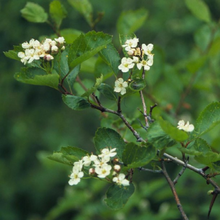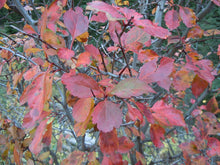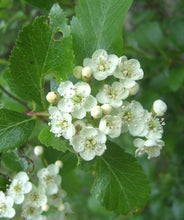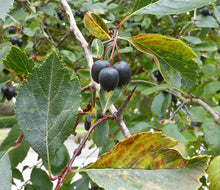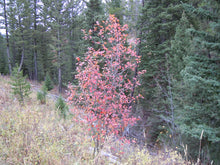
Crataegus douglasii
Douglas hawthorn, also known as black hawthorn, is a small, deciduous, often multi-stemmed tree that is particularly hardy and disease resistant, compared to its ornamental counterparts. Dark, shiny leaves unfurl in early spring, providing essential host properties to native butterfly and moth larvae. In April or May, the canopy becomes laden with dense clusters of white flowers that are visited by a plethora of insect pollinators. By fall, the leaves turn attractive hues of red, orange and yellow, which are accented by dark berries that beckon countless species of hungry songbirds. From top to bottom, all parts of this tree do magic for wildlife, making this an ideal choice for gardeners that are interested in creating habitat at home.
- Plant type/canopy layer: deciduous, perennial, small tree
- Size at maturity: 10-30' tall, 12-20' wide
- Light requirements: full sun, part sun/part shade, full shade
- Moisture requirements: moist soil
- Bloom time: April - June
- Growth rate/ease: medium growth rate, easy to grow
- Wildlife support: flowers attract and provide nectar to hummingbirds, adult butterflies, bees and other insect pollinators; berries attract and support birds such as cedar waxwings, grosbeaks, wood ducks, thrushes, robins, woodpeckers, turkeys, band-tailed pigeons, pheasants and grouse, as well as mammals such as bear, foxes, and coyotes; twigs are browsed by rabbits and deer; overall plant is a caterpillar host and larval food source for native butterflies and moths including the swallowtail butterflies, gray hairstreaks and Lorquin's admirals; when growing in wild thickets, it provides exceptional refugia and nesting habitat for birds and other wildlife
- Native habitat/range: common growing along streams, in ditches, on forest slopes, meadows, fencerows, and even sagebrush, at low to high elevations, from southern Alaska to northern California and eastward into Alberta, Montana and Idaho, with disjunctive populations to the Great Lakes region. Portland Plant List - it’s complicated! PPL lists the local native as Crataegus gaylussacia. But many sources list C. gaylussacia as synonymous with Crataegus douglasii var. suksdorfii because Suksdorf’s Hawthorn was previously considered a variety of Douglas Hawthorn. Both species/varieties are very similar and differ mostly in the number of chromosomes in each cell and the number of stamens within each flower (Douglas Hawthorn has 10 stamens, Suksdorf’s Hawthorn has 20 stamens). Suksdorf’s Hawthorn is now believed to be a parent of Douglas Hawthorn either through hybridization with another species or by doubling its own chromosome number. Many sources place both species/varieties as naturally occurring in Multnomah County and most growers don't or can't distinguish between the two - plus they hybridize. So, it's an amazing habitat tree and you should just plant it!
- Special features & uses: pollinator and wildlife favorite; highly medicinal, infusion on the shoots can be used to treat diarrhea, a poultice of the leaves to treat swollen skin, a decoction of sapwood, bark, and roots can be taken as a gastrointestinal aid; edible though not particularly delicious; other ethnobotanical uses include using the thorns for rake tines, lances and fishhooks and the hardwood as tool handles and other implements; landscape uses include woodland gardens, pollinator gardens, erosion control, habitat hedgerows and windbreaks
Gardening with Douglas Hawthorn: Hawthorns have widely variable genetics and readily hybridize with closely related species and varieties. As such, it usually can tolerate a range of sunlight and soil moisture conditions. That said, it tends to prefer mostly sunny sites with moist soil, though it will handle the summer drought just fine provided it is watered deeply, but infrequently while becoming established. This is also an excellent species in restoration plantings and bank stabilizations since the roots hold soil and resist erosion.
Photo Credit 1: "Crataegus douglasii" by Matt Lavin is licensed under CC BY-SA 2.0
Photo Credit 2: "Crataegus douglasii" by Matt Lavin is licensed under CC BY-SA 2.0
Photo Credit 3: "Hawthorn Blossoms" by born1945 is licensed under CC BY 2.0
Photo Credit 4: "20140816_2733W7thStephens_CrataegusDouglasii_Cutler_P1100510ps" by wlcutler is licensed under CC BY-SA 2.0
Photo Credit 5: "Crataegus douglasii" by Matt Lavin is licensed under CC BY-SA 2.0





